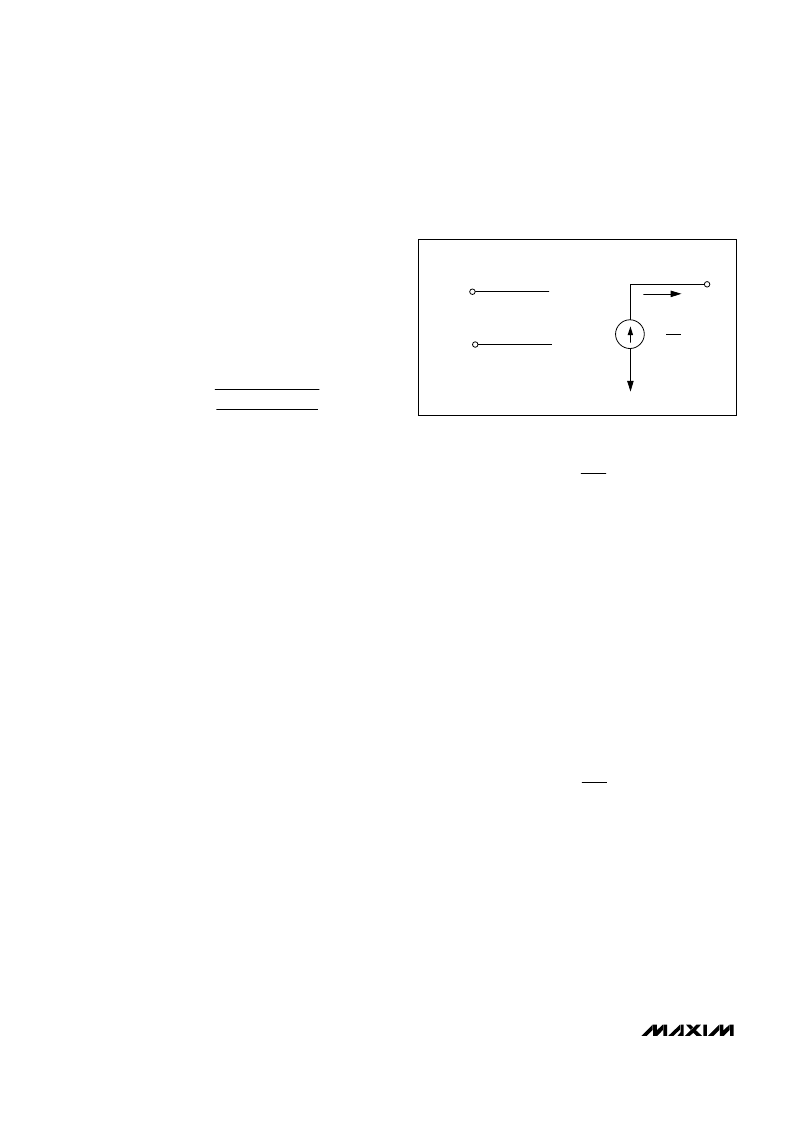- 您現(xiàn)在的位置:買賣IC網(wǎng) > PDF目錄383545 > MAX9546_07 (Maxim Integrated Products, Inc.) Differential Video Interface Chipset PDF資料下載
參數(shù)資料
| 型號: | MAX9546_07 |
| 廠商: | Maxim Integrated Products, Inc. |
| 英文描述: | Differential Video Interface Chipset |
| 中文描述: | 差分視頻接口芯片組 |
| 文件頁數(shù): | 8/12頁 |
| 文件大?。?/td> | 266K |
| 代理商: | MAX9546_07 |

M
Common-Mode Balance
A driver is typically specified as having a property called
common-mode balance (CMB), longitudinal balance, or
simply line imbalance. Although balance is associated
with the source, it assumes a perfectly balanced, cor-
rectly terminated, differential load. Common-mode bal-
ance is a measure of the ratio between the differential to
the common-mode output in decibels as shown below.
Common-mode balance is dominated by the gain-band-
width product at high frequencies and the output resis-
tance at low frequencies; therefore, it is important to
specify CMB over a frequency range. The receiver-side
balance is determined by the common-mode rejection
ratio (CMRR). The CMRR is usually quite large compared
to the CMB; therefore, the CMB is the limiting factor.
Fault Protection and Detection
The MAX9546 fault protection insures the driver outputs
survive a short to any voltage from -2V to +16V and are
ESD-protected to ±15kV HBM. Faults are indicated by
an open-drain fault output (
FAULT
) being asserted low
and requires a pullup resistor from
FAULT
to V
CC
.
MAX9547
Receiver
The MAX9547 receiver is a differential-to-single-ended
converter that removes any common-mode input. The
unique architecture allows the signal gain to be set by
a ratio of two impedances: the user-selected transcon-
ductance element or network (Z
ZT
), and an output load
resistance, R
L
. The gain is set by a fixed internal cur-
rent gain (K) and the ratio of Z
ZT
and R
L
. The ZT termi-
nals can be bridged with a complex impedance to
provide lead-lag compensation.
The output is essentially a voltage-controlled current
source as shown in Figure 1. The MAX9547 output is a
current proportional to the differential input voltage, and
inversely proportional to the impedance of the user-
selected transconductance network, Z
ZT
. The current
output provides inherent short-circuit protection for the
output terminal. A differential input voltage applied to the
input terminals causes current to flow in the transconduc-
tance element (Z
ZT
), which is equal to V
IN
/ Z
ZT
. This cur-
rent in the transconductance element is multiplied by the
preset current gain (K) and appears on the output termi-
nal as a current equal to (K) x (V
IN
/ Z
ZT
). This current
flows through the load impedance to produce an output
voltage according to the following equation:
where K = current-gain ratio (K = 1 for MAX9547), R
L
=
output load impedance, Z
ZT
= transconductance ele-
ment impedance, V
IN
= differential input voltage.
Loss-of-Signal
The receiver includes an
LOS
output to indicate a sig-
nal by detecting the presence of H-Sync. This allows
the MAX9547 to be used with monochrome or color
video.
LOS
is an open-drain output and requires a
pullup resistor from
LOS
to V
CC
.
Setting the Circuit Gain
The MAX9547 produces an output current by multiply-
ing the differential input voltage, V
IN,
by the transcon-
ductance ratio, K (R
L
/ Z
ZT
), where K = 1. The voltage
gain (A
V
) is set by the impedance of the transconduc-
tance network (Z
ZT
) and the output load impedance
(R
L
) according to the following formula:
The factor Z
ZT
is the impedance of the user-selected,
two-terminal transconductance element or network,
connected across the terminals labeled ZT+ and ZT-.
The network Z
ZT
is selected, along with the output
impedance R
L
, to provide the desired circuit gain and
frequency shaping.
To maintain linearity, the transconductance network
should also be selected so that current flowing through
it, equal to V
IN
/ Z
ZT
, does not exceed 18mA under
worst-case conditions of maximum input voltage and
minimum transconductance element impedance (Z
ZT
).
Output current should not exceed ±8.8mA except
under fault conditions.
A
K
R
Z
V
L
ZT
=
V
K
V
Z
R
OUT
IN
ZT
L
=
CMB
Log
OUT
OUT
OUT
OUT
=
+
(
(
) (
)
+
(
2
)
)
+
20
Differential Video Interface Chipset
8
_______________________________________________________________________________________
Figure 1. Operational Mode
Z
ZT
K
V
IN
V
IN
IN+
IN-
I
OUT
1
+
7
-
4
相關(guān)PDF資料 |
PDF描述 |
|---|---|
| MAX9583_0710 | Dual, Triple, and Quad Standard-Definition Video Filter Amplifiers with DC-Coupled Input Buffers |
| MAX9583 | Dual, Triple, and Quad Standard-Definition Video Filter Amplifiers with DC-Coupled Input Buffers |
| MAX9584 | Dual, Triple, and Quad Standard-Definition Video Filter Amplifiers with DC-Coupled Input Buffers |
| MAX9585 | Dual, Triple, and Quad Standard-Definition Video Filter Amplifiers with DC-Coupled Input Buffers |
| MAX9586_0710 | Single, Dual, Triple, and Quad Standard-Definition Video Filter Amplifiers with AC-Coupled Input Buffers |
相關(guān)代理商/技術(shù)參數(shù) |
參數(shù)描述 |
|---|---|
| MAX9546ESA+ | 功能描述:視頻放大器 Differential Video Interface Chipset RoHS:否 制造商:ON Semiconductor 通道數(shù)量:4 電源類型: 工作電源電壓:3.3 V, 5 V 電源電流: 最小工作溫度: 最大工作溫度: 封裝 / 箱體:TSSOP-14 封裝:Reel |
| MAX9546ESA+T | 功能描述:視頻放大器 Differential Video Interface Chipset RoHS:否 制造商:ON Semiconductor 通道數(shù)量:4 電源類型: 工作電源電壓:3.3 V, 5 V 電源電流: 最小工作溫度: 最大工作溫度: 封裝 / 箱體:TSSOP-14 封裝:Reel |
| MAX9547ESA+ | 功能描述:視頻放大器 Integrated Circuits (ICs) RoHS:否 制造商:ON Semiconductor 通道數(shù)量:4 電源類型: 工作電源電壓:3.3 V, 5 V 電源電流: 最小工作溫度: 最大工作溫度: 封裝 / 箱體:TSSOP-14 封裝:Reel |
| MAX9547ESA+T | 功能描述:視頻放大器 Integrated Circuits (ICs) RoHS:否 制造商:ON Semiconductor 通道數(shù)量:4 電源類型: 工作電源電壓:3.3 V, 5 V 電源電流: 最小工作溫度: 最大工作溫度: 封裝 / 箱體:TSSOP-14 封裝:Reel |
| MAX954C/D | 功能描述:特殊用途放大器 Ultra-Low-Power Single-Supply Op Amp + Comparator + Reference RoHS:否 制造商:Texas Instruments 通道數(shù)量:Single 共模抑制比(最小值): 輸入補償電壓: 工作電源電壓:3 V to 5.5 V 電源電流:5 mA 最大功率耗散: 最大工作溫度:+ 70 C 最小工作溫度:- 40 C 安裝風(fēng)格:SMD/SMT 封裝 / 箱體:QFN-20 封裝:Reel |
發(fā)布緊急采購,3分鐘左右您將得到回復(fù)。